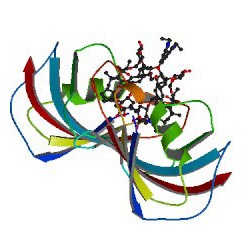
This article review was written by guest author, Amy Landreman, in the Cellular Analysis and Proteomics Group at Promega.
Charcot-Marie Tooth (CMT) disease is one of the most common inherited neurological disorders affecting approximately 2.8 million people worldwide. The most common form of CMT, CMT Type 1A, is caused by a 1.5Mb genomic duplication on Chr17 that results in trisomy of the critical myelin gene Peripheral Myelin Protein 22 (Pmp22). The extra copy of Pmp22 results in excessive PMP22 protein causing the neurophathy associated with CMT type 1A. Although there is no way to remove the extra copy of the gene, even subtle decreases in Pmp22 expression have shown promise against this inherited neuropathy in laboratory models.
In a recent paper, Inglese et al. 2014, describe an interesting new approach used to identify compounds that effectively decrease Pmp22 expression using a novel gene editing strategy and reporter-based screen. Their challenge was to create an assay that accurately represented endogenous Pmp22 expression including both transcriptional and post-transcriptional regulatory mechanisms, while maintaining the sensitivity required to detect subtle changes in expression in a loss of signal assay in a format compatible with microtiter 1536-well quantitative high-throughput screening (qHTS).
Their solution used advances in genome editing techniques (TALENs) and reporter technologies (NanoLuc® Luciferase) to develop a Schwann cell line that could be used for high-throughput screening of compound libraries. In their model, TALENs were used to insert the secrete NanoLuc (secNluc) Luciferase reporter at the 3’ end of the endogenous Pmp22 coding sequence. GFP was also inserted to enable efficient sorting of transfected cells. The viral 2a ribosome staggering sequence was included to separate the Pmp22, secNluc, and GFP ORFs in order to generate independent proteins, and the inserts were done upstream of the native 3’UTR to include miRNA post-transcriptional regulation. The result was a cell line that expressed Pmp22, secNLuc, and GFP on the same RNA using the endogenous genetic and epigenetic elements that govern Pmp22 transcription in its native chromatin context. Using the bright, secreted NanoLuc reporter as a measure of Pmp22 transcriptional activity provided simple assay methodology with the sensitivity to detect endogenous expression levels even in small 4ul assay volumes. Counter screens were also performed with a similar Gaussia Luciferase cell line as an orthogonal reporter and also using CellTiter-Glo® to measure cytotoxicity.
Using this approach a potent inhibitor of Pmp22 expression, bryostatin, was identified. The authors remark that the technique of using a reporter embedded within the endogenous gene locus together with the qHTS approach enabled the identification of this new compound which had been missed in other screens. Interestingly, bryostatin is a potent modulator of PKC which has led to a new understanding of PKC-associated regulation of Pmp22 and provides a new molecular pathway involved in CMT. Engineered reporter cell lines such as the one described here provide a powerful new methodology to develop endogenous pathway assays that are well suited to high-throughput approaches and provide new means to discover novel mechanisms of action and expanded molecular targets for diseases such as CMT.
Citation
Inglese, J. et al. (2014) Genome Editing-Enabled HTS Assays Expand Drug Target Pathways for Charcot–Marie–Tooth Disease. ACS Chemical Biology epub ahead of print.
Latest posts by Promega (see all)
- Immune Surveillance Meets Innovation: The Critical Need for dsRNA Detection - April 22, 2025
- Beyond Ozempic: The New Frontier of Obesity Research - April 18, 2025
- One Health and H5N1: Promega’s Commitment to Holistic Solutions - April 8, 2025
